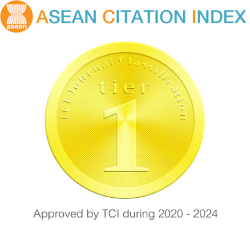Diabetes and Hypertension Screening Platform for Sub-District Health Promoting Hospital to Track Community Health
Keywords:
diabetes, hypertension, screening system, noncommunicable diseasesAbstract
Background and Rationale: This subproject aimed to develop a digital platform for diabetes and hypertension screening for sub-district health promoting hospital (SHPH) to tract community health to align with efficient community development of the big project.
Methodology: This participatory action research involved 3 target areas of 3 SHPHs (Khaotum, Yarang, and Ma’mawi) and 3 sub-district administrative organizations (SAOs: Yarang, Pakoo, and Sakhobon) in Pattani province. The research process began with community survey to analyze the problems of executives in using data for decision-making. The big project offered platforms to executives for monitoring and decision-making. The platform of diabetes and hypertension screening to monitor community health was developed for the present study. Executives were able to access health data for planning and decision-making. The research recruited 39 samples representing 4 groups of stakeholders: 6 SAO executives and employees, 9 executives and nurses of SHPHs, 9 village health volunteers (VHVs), and 15 patients/relatives. The samples were selected purposively (from SOAs and SHPHs) and randomly (VHVs and patients). Questionnaires and interviews were tools for evaluating satisfaction and the platform uses.
Results: The development of the digital platform solved data problems with convenient use and high satisfaction to users through serial trainings. Evaluation using questionnaires and interviews found that: 1) the change of community health screening from a manual (paper) based to digital based delivered accurate, fast, convenient, and systematically stored database for real time use. This helped future planning operations on tracking community health. 2) SHPH and SOA could see trends of community health problems at real time and plan to mitigate problems with precision, clarity, and accuracy. 3) The platform served as communication and collaboration medium between SOA, SHPH, VHVs, and target groups. 4) It could facilitate the basic health screening, make an appointment for treatment and follow-up for people in need. Post-training evaluation of platform use skill was at high score.
Suggestions: Responsible officers in monitoring community health and service users should receive comprehensive, clear and easy-to-understand training on the use of this new platform.
References
Kaewtha S, Khamwangsanga P, Kanchanapibulwong A. Situation report on NCDs: diabetes, hypertension and related risk factors 2019. 1st ed. Aksorn Graphic and Design Publishing; 2020. p. 1-85. (in Thai)
Department of Disease Control. Diabetes, high blood pressure knowledge and direction of operations in the field of non-communicable diseases and evaluation, fiscal year 2024. (in Thai)
Division of Noncommunicable Diseases/Risk Communication Office, Department of Disease Control. The Department of Disease Control invites people aged 35 and over to screen for diabetes and hypertension, revealing that 8 million Thais still do not have access to the screening system [internet]. 2023 Mar [cited 2024 May 20]. Available from: https://ddc.moph.go.th/brc/news.php?news=32939&deptcode=brc&news_views=254. (in Thai)
Sripotong S, Theerakarn S, Wannapira W. Development of diabetes and hypertension screening system with community network participation in urban primary care cluster. Buddhachinaraj Med J 2020;37(3):336-46. (in Thai)
Khiewsa-ard P. Digital skills of government officers and staffs of customs department on challenge of organizational development to digital transformation (master thesis). Bangkok: Department of Public Administration and Public Affairs, Faculty of Political Science, Thammasat University; 2019.
Malisuwan S. Digital transformation for Thailand 4.0. NBTC Journal 2560;2(2):23–48. (in Thai)
Cornish F, Breton N, Moreno-Tabarez U, Delgado J, Rua M, de-Graft Aikins A, et al. Participatory action research. Nature Reviews Methods Primers 2023;3(1);1-14.
Leksono F, Sugianto D. Understanding South Tangerang’s generation Z during 2019 student protest through empathy map canvas. Proceedings of the 1stConference of Visual Art, Design, and Social Humanities by Faculty of Art and Design; 2019 Nov 2; Surakarta, Central Java, Indonesia.
Guthrie G. Ideation tips to make your design team a creative powerhouse [blog on the internet]; 2022 Feb 21 [cited 2024 Aug 22]. Available from: https://nulab.com/learn/designand-ux/ideation-tips-make-your-design-team-creative-powerhouse/.
Jongsareejit A. Screening system development for cataracts and glaucoma in community: a case study of community health center in Lak Ha Subdistrict Municipality in Amphoe Ban Phaeo in Samut Sakhon Province. Journal of Liberal Arts, Maejo University 2015;3(1):37-57. (in Thai)
Ruttawongsa A. Development of a screening model for diabetic retinopathy. Journal of Environmental and Community Health 2020;5(2):86-94. (in Thai)
Kaewsrem S, Saikamnor E. Development of a screening system for individuals at risk of diabetes. Journal of Technology Management Rajabhat Maha Sarakham University 2022;9(2):7-17. (in Thai)
Jongkasikit NN. Decision support system for analyzing the risk of chronic disease in cases of diabetes and high blood pressure. Industry Technology Lampang Rajabhat University 2016;9(2):9-9. (in Thai)
Maneelert C. The developing of an application to screen people at risk for diabetes and high blood pressure. Rajabhat Chiang Mai Research Journal 2021;22(3):109-25.
Downloads
Published
How to Cite
Issue
Section
License
Copyright (c) 2024 Journal of Health Systems Research

This work is licensed under a Creative Commons Attribution-NonCommercial-NoDerivatives 4.0 International License.
Journal of Health Systems Research is licensed under a Creative Commons Attribution-NonCommercial-NoDerivatives 4.0 International (CC BY-NC-ND 4.0) license, unless otherwise stated.




